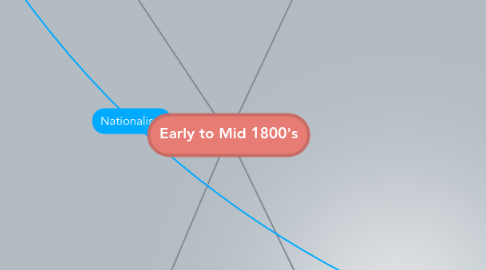
1. Social
1.1. Embargo Act (1807)
1.1.1. Used to stop impressment on U.S. sailors, no exports could come to the U.S.
1.2. Non-intercourse act of 1809
1.2.1. Created to help stop seizing of American Vessels from France and Great Britian
1.3. Sectionalism and Nationalism were big components
1.3.1. Identify Project Resources
1.3.2. Recruit Project Steering Committee
1.3.3. Recruit Project Coordinators
1.3.4. Identify / Recruit Key Stakeholders
1.3.5. Determine Training Requirements
1.3.6. Map the Project Organization Chart
1.3.7. Review Project Organization
1.4. U.S. ended legal participation in the global slave trade in 1808.
1.4.1. Establish Project Administration Procedures
1.4.2. Establish Quality Control Procedures
1.4.3. Establish Progress Control Procedures
1.4.4. Establish Change Control Procedures
1.4.5. Establish Issue Resolution Procedure
1.4.6. Review Project Control Procedures
1.5. Slavery demand started to increase in early 1800's
1.5.1. Prepare Initiation Stage Assessment
1.5.2. Review Initiation Stage Assessment
1.5.3. Follow-Up Initiation Stage Assessment
1.5.4. Compile Project Initiation Report
1.6. Trail of Tears (Indian Removal Act) (1838 and 1839)
1.6.1. Indians were forced out of their native land to make room for "Americans". 1 in every 4 cherokee indians died on the Trail of Tears
2. Reformation Era
2.1. Camp Meetings
2.1.1. Began to promote revivalist; becoming "renewed" to reform religion.
2.2. Spiritual Egalitarianism
2.2.1. Was one of the most important transformations to emerge out of the 2nd Great Awakening. It's the thought of religion equality.
2.3. Nat Turner leads slave revolt in 1831
2.4. Seneca Fall Convention of 1848
2.4.1. The first women's rights meeting in America. It's purpose was to bring attention to the unequal treatment of women. Lucretia Mott, Martha Wright, and Elizabeth Stanton were the organizer's of the convention.
2.5. Grimke Sisters
2.5.1. Born in the more wealthier part of the South and were the first white people, of both men and women, from this part of the South to advocate abolition.
2.6. New Inventions
2.6.1. John Deere: Steele plows
2.6.2. Cyrus McCormick: Mechanical reaper
2.7. More than 5 millions immigrants (irish, german, jewish) arrived in Ameriica between 1820-1860
2.8. Abolitionists include William Garrison, David Walker, and Frederick Douglass.
3. Economical
3.1. Thomas Jefferson and Andrew Jackson thought people should be able to regulate their own affairs.
3.1.1. Leads to the non renewal
3.2. Second National Bank was chartered to try and pay off war debts from the War of 1812
3.2.1. Determine Frequency of Meetings
3.2.2. Schedule Meetings
3.2.3. Brief Project Board
3.2.4. Prepare Meetings
3.2.5. Conduct Meetings
3.2.6. Follow-up Meeting
3.3. Louisiana Purchase (1803)
3.3.1. Nearly doubled American territory
3.3.2. Payed off debts to France
3.4. Panic of 1819
3.4.1. A lot of people blamed the 2nd B.U.S. but was actually caused by England's decreased demand of American goods.
3.5. Tariff of Abominations (1828)
3.5.1. Increased tax on foreign goods designed to protect the North but affected the South by preventing trade relations with England
3.6. The American System (1812)
3.6.1. North was the "Industrial king
3.6.2. South was the "Agriculture" king
3.7. Eli Whitney created Cotton Gin (1794)
3.7.1. Determine Next Stage Tasks
3.7.2. Determine Task Dependencies
3.7.3. Estimate Effort
3.7.4. Allocate Resources
3.7.5. Prepare Next Stage Schedule
3.7.6. Prepare Next Stage Budget
3.7.7. Update Project Schedule
3.7.8. Update Project Budget
3.7.9. Review Business Case
3.7.10. Review Project Organization
3.7.11. Review Project Scope
3.7.12. Prepare Stage Assessment
3.7.13. Review Stage Assessment
3.7.14. Follow-Up Stage Assessment
3.7.15. Compile Stage Closure Report
4. Political
4.1. Chesapeake Incident of 1807
4.1.1. British Navy came and wanted to take deserters from the Chesapeake ship, they took four men but only one was an actual deserter, the rest were Americans.
4.2. Democratic-Republican Party was created under James Madison.
4.2.1. Prepare Project Review
4.2.2. Conduct Project Review
4.2.3. Implement Process Improvement
4.3. "Era of Good Feelings" (1817-1825)
4.3.1. There was no political tension in America; only one political party: Democratic-Republican.
4.4. Hartford Convention (1815)
4.4.1. Federalists came together to discuss secession, American people lost faith in the Federalists when they found out and that was the end of federalists.
4.5. "Know-Nothing" Party (1849)
4.5.1. Anti-catholic and anti-immigrant sentiment
4.6. Whig-Party (1833-1856)
4.6.1. Political party that formed that were "Jackson Haters"
4.7. Democratic party (1828)
4.7.1. Jackson Supporters that was the nation's first highly organized national political party.
